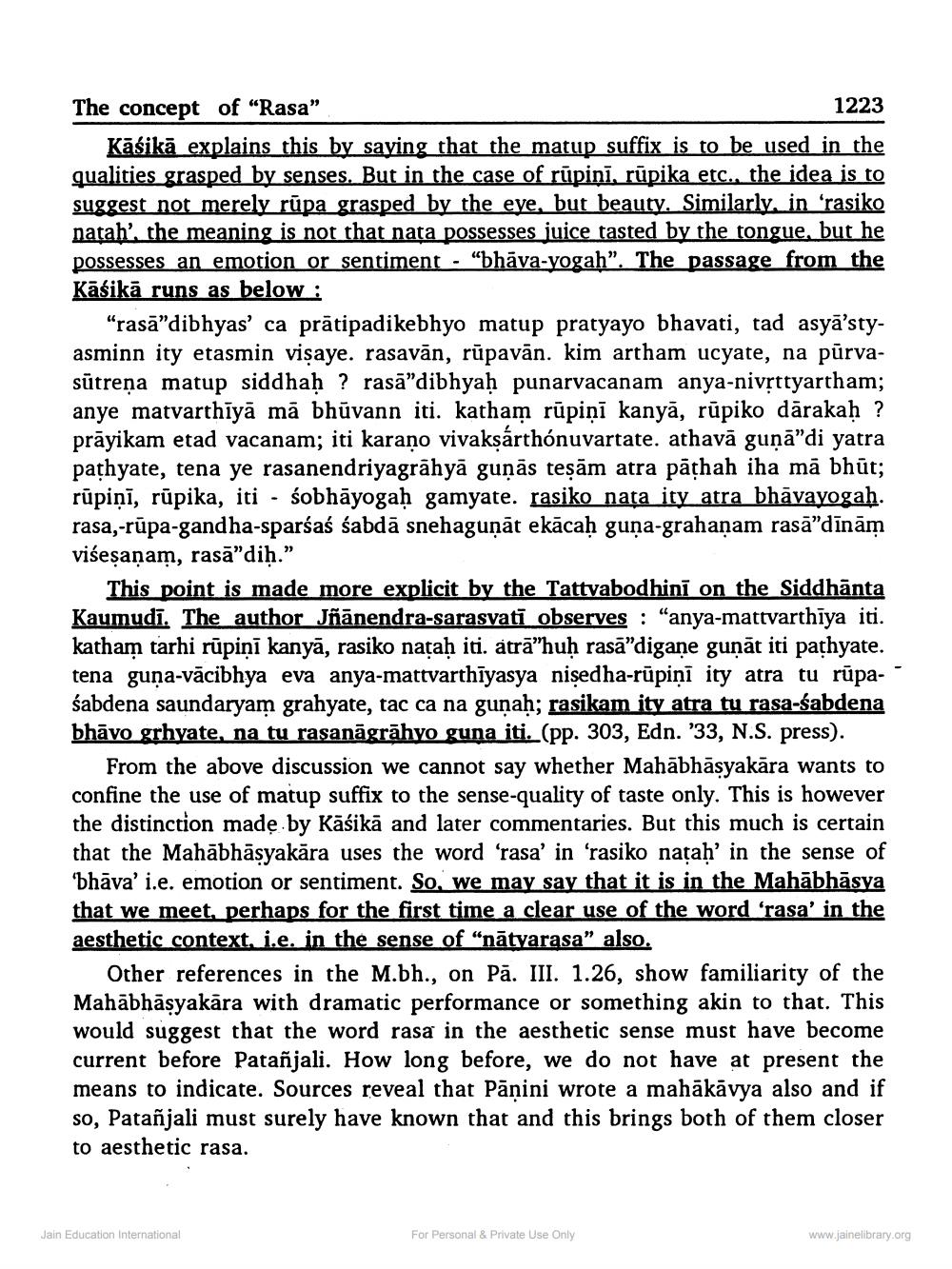________________
The concept of "Rasa"
1223
Kāśikā explains this by saying that the matup suffix is to be used in the qualities grasped by senses. But in the case of rūpiņī, rūpika etc., the idea is to suggest not merely rūpa grasped by the eye, but beauty. Similarly, in ‘rasiko natah', the meaning is not that nata possesses juice tasted by the tongue, but he possesses an emotion or sentiment - "bhāva-yogah". The passage from the Kāśikā runs as below:
"rasa"dibhyas' ca prātipadikebhyo matup pratyayo bhavati, tad asya'styasminn ity etasmin viṣaye. rasavān, rūpavān. kim artham ucyate, na pūrvasūtreņa matup siddhaḥ ? rasā"dibhyaḥ punarvacanam anya-nivṛttyartham; anye matvarthīyā mā bhūvann iti. katham rūpiņī kanyā, rūpiko dārakaḥ ? prāyikam etad vacanam; iti karaṇo vivakṣárthónuvartate. athavā guṇā”di yatra pathyate, tena ye rasanendriyagrāhyā guṇās teṣām atra pāṭhah iha mã bhūt; rūpiṇī, rūpika, iti sobhāyogaḥ gamyate. rasiko nata ity atra bhāvayogaḥ. rasa,-rūpa-gandha-sparśaś śabdā snehaguṇāt ekācaḥ guna-grahanam rasā❞dīnām viseṣaṇam, rasā"diḥ."
-
This point is made more explicit by the Tattvabodhini on the Siddhanta Kaumudi. The author Jñanendra-sarasvati observes: "anya-mattvarthīya iti. katham tarhi rūpiņī kanyā, rasiko naṭaḥ iti. atrā"huḥ rasa"digane gunāt iti pathyate. tena guṇa-vācibhya eva anya-mattvarthīyasya niṣedha-rūpiņī ity atra tu rūpaśabdena saundaryam grahyate, tac ca na gunah; rasikam ity atra tu rasa-śabdena bhāvo grhyate, na tu rasanāgrāhyo guna iti. (pp. 303, Edn. '33, N.S. press).
From the above discussion we cannot say whether Mahābhāṣyakāra wants to confine the use of matup suffix to the sense-quality of taste only. This is however the distinction made by Kāśikā and later commentaries. But this much is certain that the Mahabhāṣyakāra uses the word 'rasa' in 'rasiko naṭaḥ' in the sense of 'bhāva' i.e. emotion or sentiment. So, we may say that it is in the Mahābhāsva that we meet, perhaps for the first time a clear use of the word 'rasa' in the aesthetic context, i.e. in the sense of "nātvarasa" also.
Other references in the M.bh., on Pa. III. 1.26, show familiarity of the Mahābhāṣyakāra with dramatic performance or something akin to that. This would suggest that the word rasa in the aesthetic sense must have become current before Patanjali. How long before, we do not have at present the means to indicate. Sources reveal that Panini wrote a mahākāvya also and if so, Patanjali must surely have known that and this brings both of them closer to aesthetic rasa.
Jain Education International
For Personal & Private Use Only
www.jainelibrary.org




